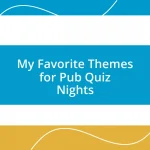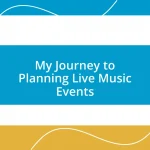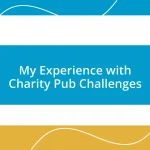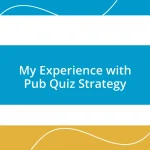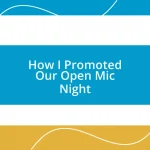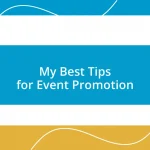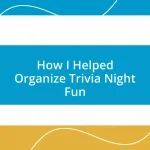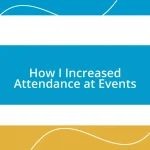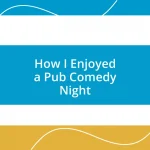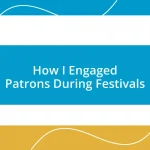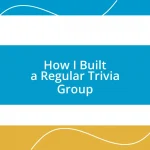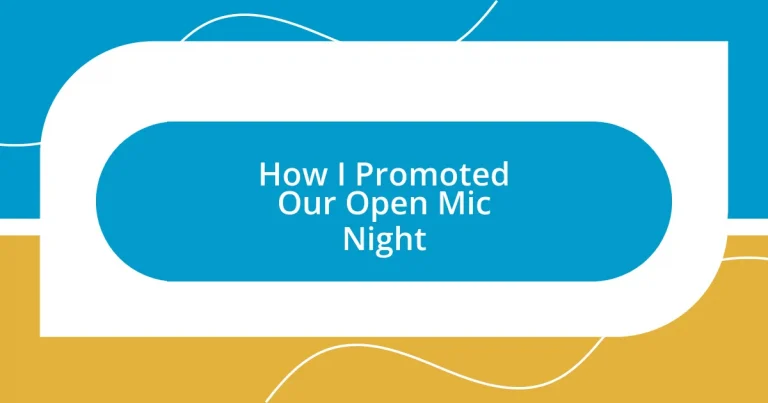Key takeaways:
- The open mic concept fosters confidence and community, allowing individuals to express their creativity and share personal stories.
- Identifying the target audience and using effective promotion channels, such as social media and local partnerships, significantly enhances event success and participation.
- Gathering feedback and measuring success through attendee interaction and social media engagement informs improvements for future events, emphasizing the importance of community connections.
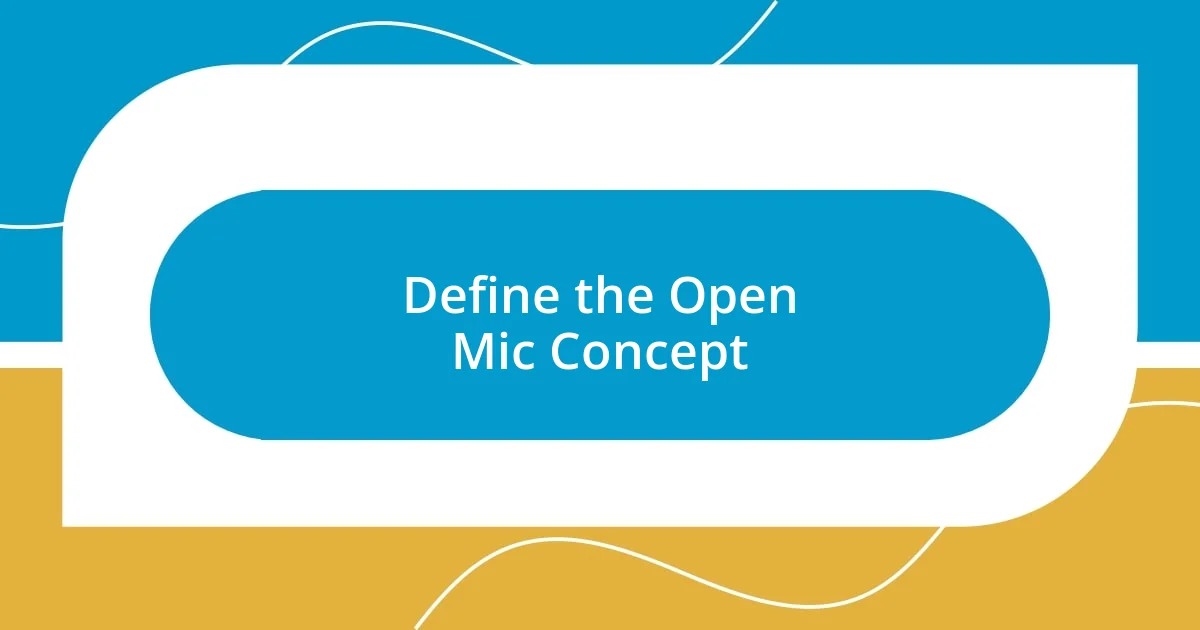
Define the Open Mic Concept
The open mic concept invites individuals to step into the spotlight, giving them a platform to share their talents and creativity, whether it’s poetry, music, or comedy. I remember my first time performing at an open mic; the nervous anticipation was palpable, yet that stage buzzed with energy and possibility. Isn’t it fascinating how such a simple idea can ignite confidence in shy individuals and create a vibrant community?
At its core, an open mic fosters a sense of belonging and encourages artistic expression without judgment. I’ve seen countless performers transform as they share their craft, their true selves unveiled to an audience that cheers them on. Have you ever experienced that moment when someone pours their heart into a performance, and you can practically feel the collective heartbeat of the crowd?
Each open mic night builds bridges between the performers and the audience, creating an intimate experience where stories are shared and celebrated. I can still recall the connection I felt with strangers when I listened to a heartfelt poem that resonated with my own struggles. It made me wonder: how often do we find ourselves in spaces where we can truly listen to and understand one another?
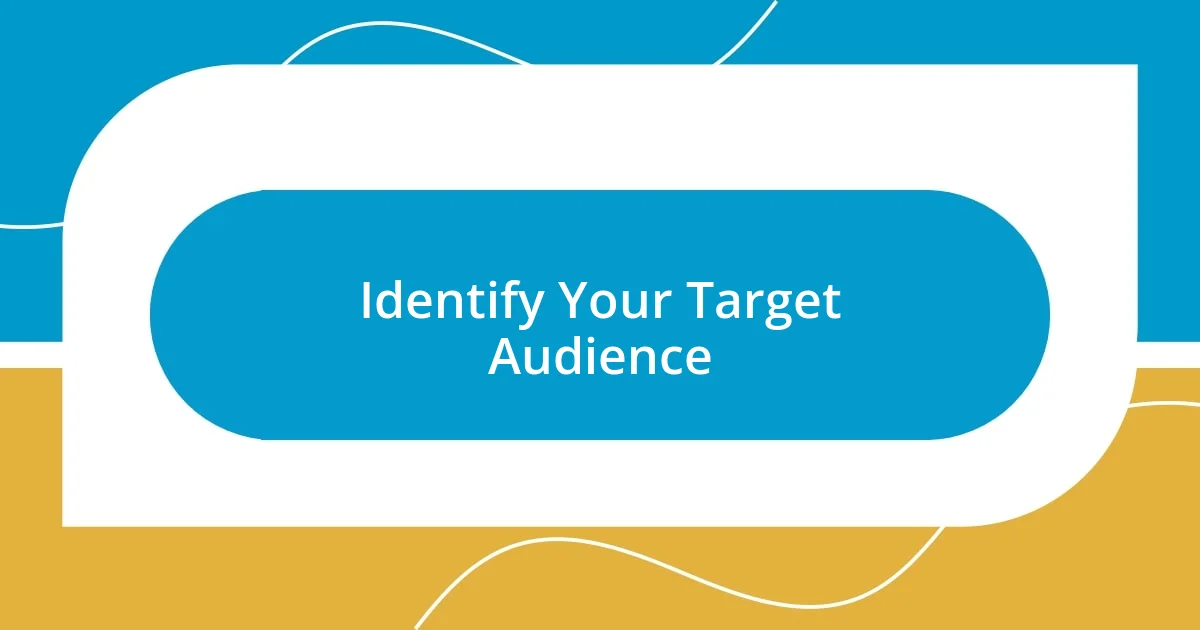
Identify Your Target Audience
Understanding your target audience is essential for elevating the atmosphere of your open mic night. When I first organized one, I spent time getting to know the community. I discovered that many were aspiring artists looking for a supportive environment to showcase their work. It was a revelation that shaped my marketing approach and ensured I engaged the right crowd.
Here are some key aspects to consider when identifying your target audience:
- Demographics: Age, gender, and location of potential participants can guide your promotion strategies.
- Interests: Determine whether your audience is more inclined toward spoken word, music, or comedy. I recall a night focused solely on poetry that attracted passionate literary fans.
- Experience Level: Are you targeting seasoned performers or newcomers? When I catered to both, it created a welcoming and inspiring environment for all.
- Social Groups: Identify local clubs, schools, or organizations that may have members interested in performing.
- Communication Style: Find out how your audience prefers to hear about events—social media, newsletters, or word-of-mouth? Tailoring messages to their preferences made a big difference in turnout.
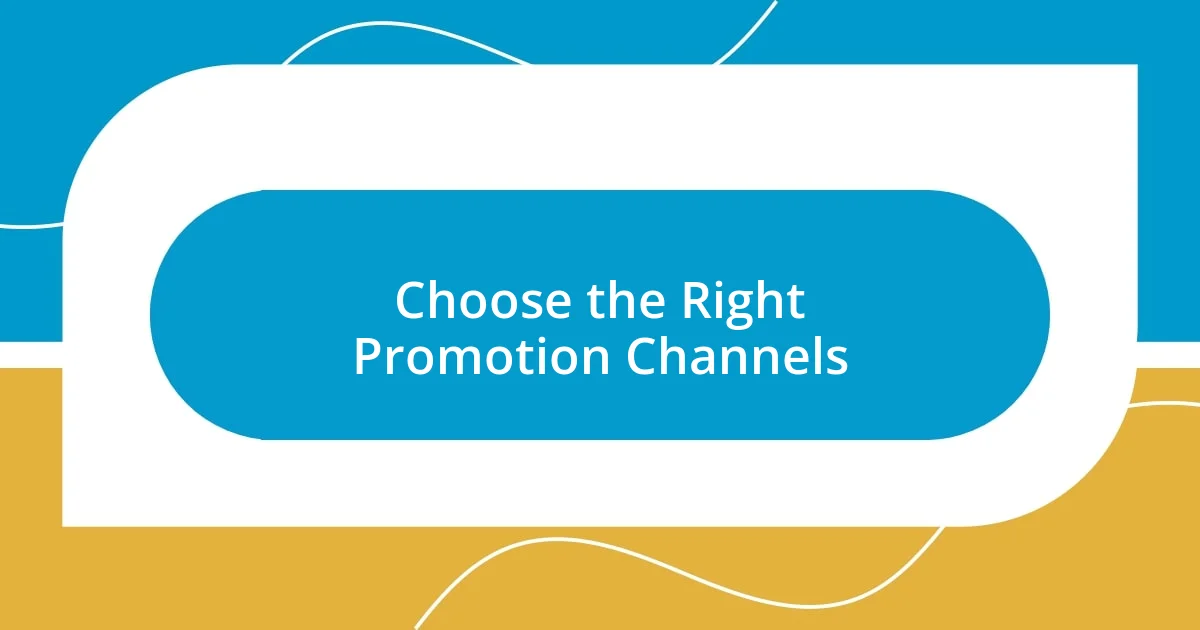
Choose the Right Promotion Channels
When it comes to promoting your open mic night, selecting the right channels can drastically influence your success. In my experience, social media has proven to be a game-changer. Platforms like Instagram and Facebook allow you to tap into local communities, share engaging visuals, and create buzz with just a few clicks. I remember posting a vibrant video from a previous event that drew in a crowd; it was heartwarming to see people excitedly sharing it within their circles.
Print media, though seeming old-fashioned, still has its charm. I once designed eye-catching flyers and hung them at local coffee shops and bookstores. The response was astonishing, as many attendees mentioned they found out about the event through a simple flyer they noticed. On the other hand, word-of-mouth remains the classic and reliable method, especially when building a loyal audience. I often encourage performers to invite friends and share their excitement; it creates a ripple effect that energizes the community.
Lastly, consider event platforms like Eventbrite or local event calendars. I discovered these tools when I organized a themed night, and they made it easier for people to find and register for the event. Sometimes, people just need a little nudge, and these channels serve as that perfect reminder.
| Promotion Channel | Advantages |
|---|---|
| Social Media | Wide reach, instant engagement, visual appeal |
| Print Media | Tangible presence, localized impact, artistic display |
| Word-of-Mouth | Authentic recommendations, community building |
| Event Platforms | Easy registration, organized event visibility |
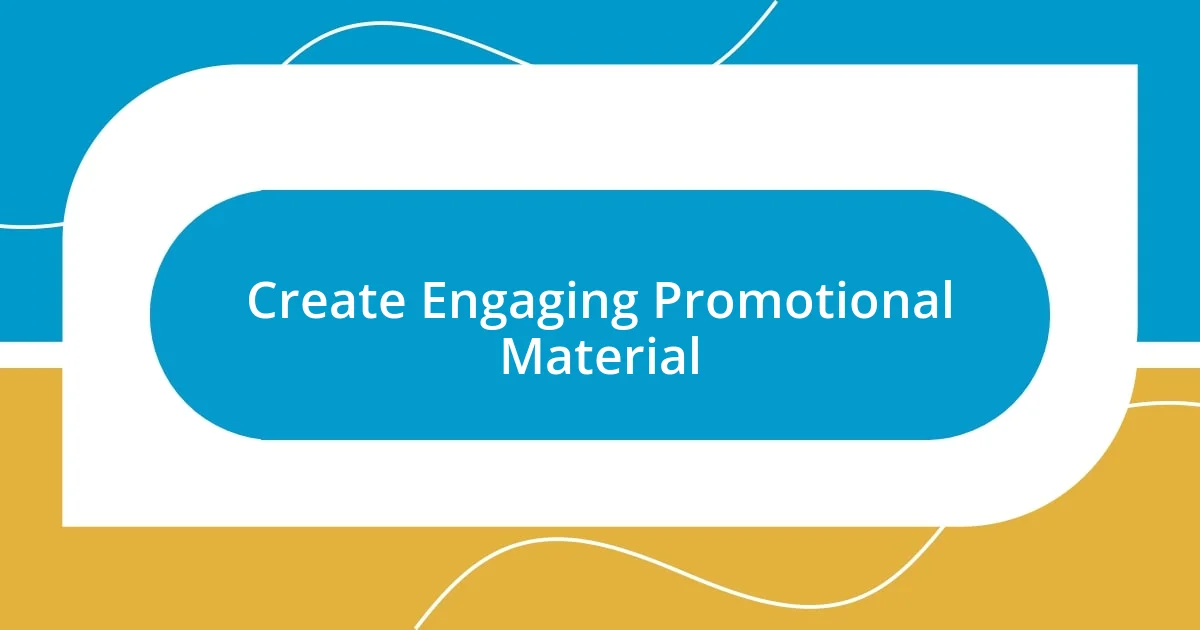
Create Engaging Promotional Material
Creating engaging promotional material is all about capturing the spirit of your event. I remember when I crafted a vibrant poster for one of our themed nights, using bold colors and dynamic images of performers from past events. It wasn’t just visually appealing; it spoke to the energy of the night. I asked myself, “What do I want people to feel when they see this?” That perspective helped me design something that resonated with the community.
In my experience, storytelling can be a powerful tool in promotional materials. I once shared a touching story of a local artist who found their voice at our open mic night, which really struck a chord. It drew in folks who were curious about the magic that happens in that setting. When you share these personal narratives, you create an emotional connection that can compel individuals to attend, sparking curiosity and excitement.
Lastly, remember to utilize a clear call to action in every piece of your promotional material. I found that simply telling people, “Join us to share your art!” made a significant difference. It invites participation, making it feel personal and inclusive. When crafting your invitations, ask yourself: “What do I want my community to take away from this?” It’s about weaving their potential experiences into the promotional narrative.
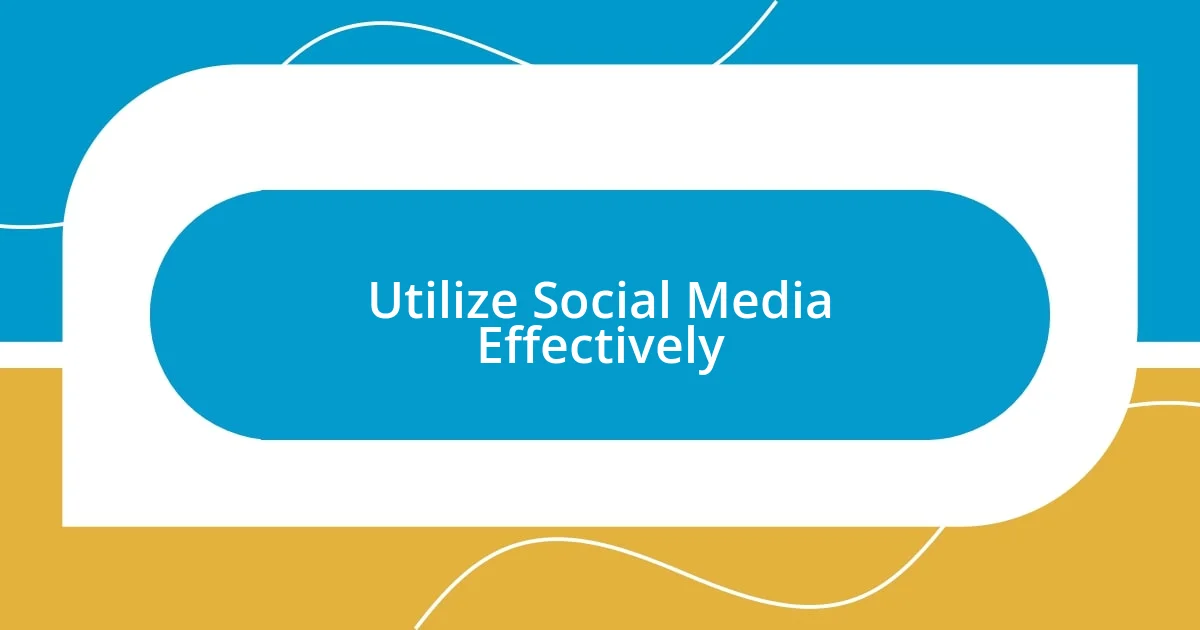
Utilize Social Media Effectively
Utilizing social media effectively was crucial for our open mic night’s success, and I learned a lot from my experiences. One moment that stands out was when I live-streamed a few performances on Instagram. I discovered that not only did it attract viewers who couldn’t attend in person, but it also generated excitement and engagement from those tuning in from afar. I often wonder how many people were inspired to come out to a future event simply because they felt a part of the magic, even if they were miles away.
I found that creating a dedicated event page on Facebook made a significant difference as well. It provided a space for attendees to interact, share their anticipation, and even discuss their favorite performers. I remember feeling a rush of joy when I noticed threads of conversation blossoming in the comments. Seeing that community building unfold in real time was rewarding, and it reinforced the idea that social media is more than just a promotional tool; it can create genuine connections.
Don’t underestimate the power of behind-the-scenes content either. I often posted sneak peeks of what goes into organizing the event, like setting up the stage or rehearsing with performers. It made the process feel relatable and authentic. Do you think that showing vulnerability in this way invites more people to join in? I believe it does. It opens the door for others to share their experiences and feel included in the journey—making our open mic night not just an event but a community celebration.
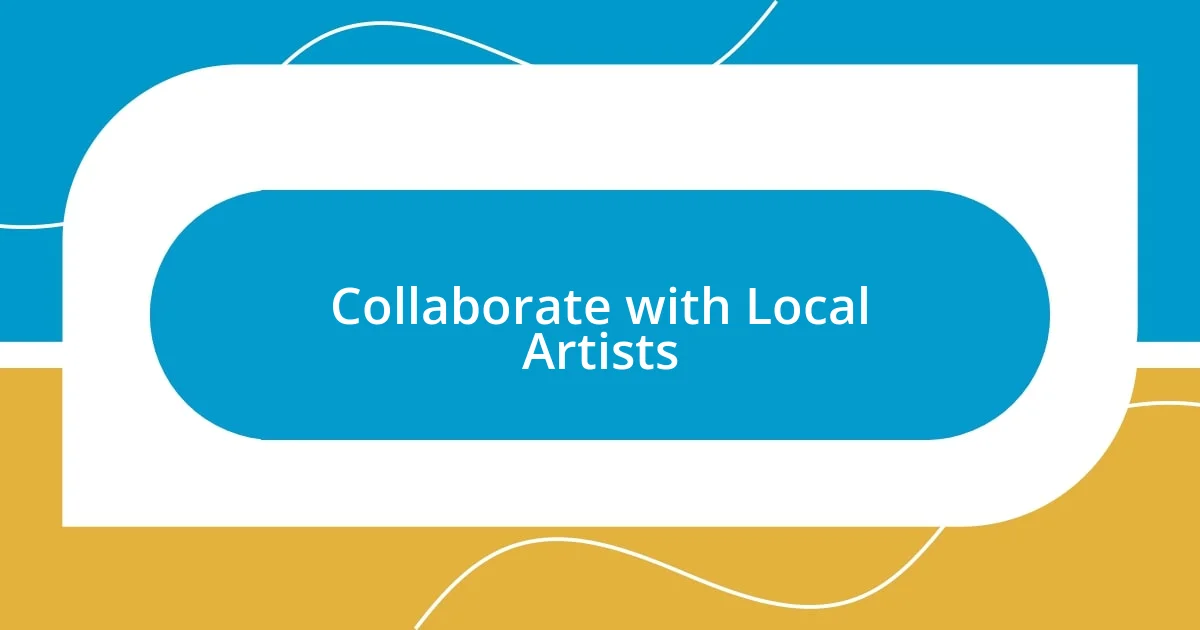
Collaborate with Local Artists
Working alongside local artists made our open mic night truly special. I still remember the excitement I felt when I reached out to a budding musician I had met at a café, sharing that we were looking to showcase emerging talent. Collaborating with her not only enriched our lineup but also brought her dedicated followers who were eager to support her. It dawned on me that each artist we invited added a unique layer to our community—how could we capitalize on that?
I also learned the power of creating partnerships with local art collectives. I had the chance to join forces with a nearby photography club, and together we created stunning visuals for our events. Their enthusiasm infused our promotional materials with artistic flair, making our marketing efforts stand out. I couldn’t help but reflect: when we combine our talents, we elevate the entire experience for everyone involved. Doesn’t it feel great to collaborate and celebrate each other’s strengths?
Lastly, inviting local poets to showcase their work forged connections that I hadn’t anticipated. After one event, a poet confided that our open mic night had reignited her passion for writing. Hearing how we provided her with a platform to share her voice filled me with joy. Each collaboration had a ripple effect, drawing in more attendees and turning our event into a tapestry of local talent. Isn’t it inspiring how a single performance can spark creativity and community in amazing ways?
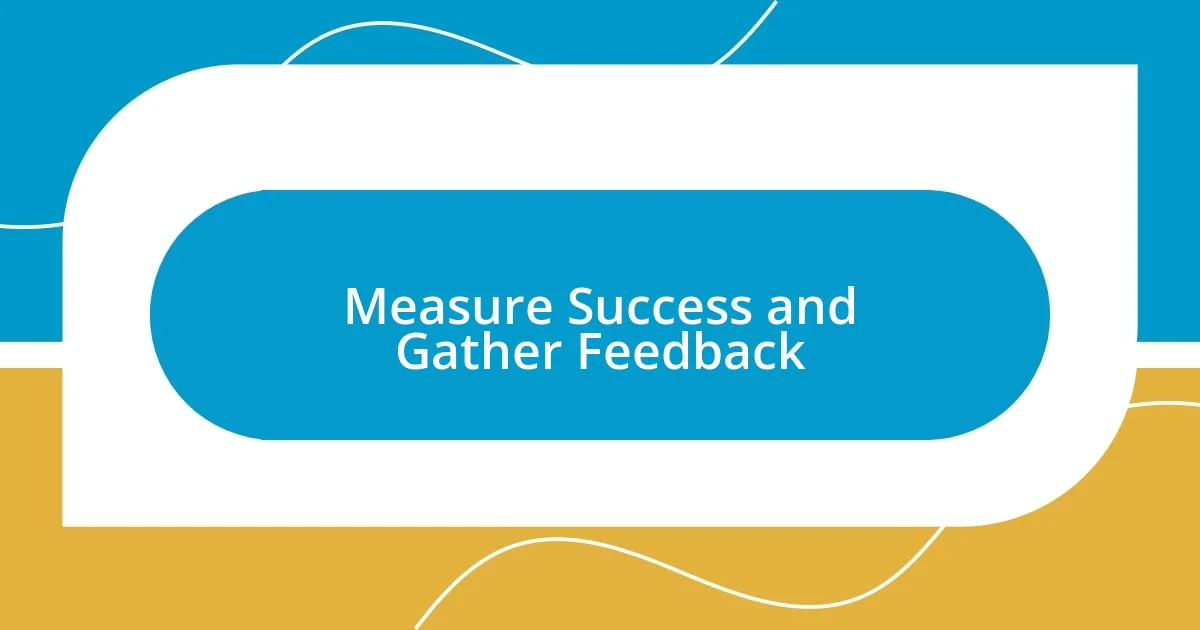
Measure Success and Gather Feedback
To truly understand the impact of our open mic night, I realized the importance of measuring success and gathering feedback. After each event, I made it a point to chat with attendees, asking them what they liked and what could be improved. One night, a young girl excitedly shared how our event helped her overcome her fear of performing. It struck me then—her feedback was not just data; it was a testament to the safe space we had created.
Surveys became my best friend in this process. I crafted simple, engaging questions that made it easy for people to express their thoughts, like: “What was your favorite moment of the night?” Surprisingly, some responses highlighted aspects of the event I hadn’t considered, such as the ambiance or a specific performer’s charm. This made me wonder, how many little details contribute to the overall experience? Every piece of feedback became a stepping stone for me to refine and enhance our future events.
I also found it valuable to track social media engagement, such as likes, shares, and comments, to gauge our reach. One post received an overwhelming number of reactions and sparked a meaningful dialogue among our audience. Reflecting on this, I realized that even digital interactions can give us a glimpse into the community’s heart. Isn’t it fascinating how success isn’t just measured in numbers but also in the stories and connections we cultivate along the way?
